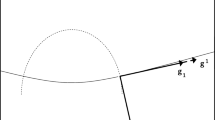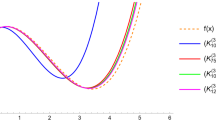Abstract
Variable-mass systems are not included in the conventional domain of the analytical and variational methods of classical mechanics. This is due to the fact that the fundamental principles of mechanics were primarily conceived for constant-mass systems. In the present article, an analytical and variational formulation for variable-mass systems will be proposed. This will be done from the solution of the here called ‘inverse problem of Lagrangian mechanics for Meshchersky’s equation’. The first problem of this nature was posed in 1887, by Helmholtz (J. reine angew. Math. 100:137–166, 1887). Investigations on the matter are far from being exhausted. Within mechanics, it means the construction of a Lagrangian from a given equation of motion. To the authors’ best knowledge, aiming at general results, the inverse problem of Lagrangian mechanics has not been properly connected to Meshchersky’s equation yet. This is the main goal of this article. We will address the issue by assuming that mass depends on generalized coordinate, generalized velocity and on time. After the construction of a Lagrangian from Meshchersky’s equation, a general and unifying mathematical formulation will emerge in accordance. Therefore, variable-mass systems will be accommodated at the level of analytical mechanics. A variational formulation, which will be written via a principle of stationary action, and a Hamiltonian formulation will be both stated. The latter could be read as the ‘Hamiltonization’ of variable-mass systems from the solution of the inverse problem of Lagrangian mechanics. An energy-like conservation law will naturally appear from the simplification of the general theory to the case of a system with mass solely dependent on a generalized coordinate.
Similar content being viewed by others
References
Berdichevsky V.L.: Variational Principles of Continuum Mechanics I. Fundamentals. Springer, Berlin, Heidelberg (2009)
Pars L.A.: A Treatise on Analytical Dynamics. Heinemann, London (1965)
Lanczos C.: The Variational Principles of Mechanics. Dover, New York (1970)
Riewe F.: Nonconservative Lagrangian and Hamiltonian mechanics. Phys. Rev. E. 53(2), 1890–1899 (1996)
Santilli R.M.: Foundations of Theoretical Mechanics I. The Inverse Problem in Newtonian Mechanics. Springer, New York (1978)
Whittaker E.T.: A Treatise on the Analytic Dynamics of Particles and Rigid Bodies. Cambridge University Press, Cambridge (1904)
Irschik H., Holl H.J.: Mechanics of variable-mass systems—part 1: balance of mass and linear momentum. Appl. Mech. Rev. 57(2), 145–160 (2004)
Eke F.O., Mao T.C.: On the dynamics of variable mass systems. Int. J. Mech. Eng. Educ. 30(2), 123–136 (2002)
Havas P.: The range of application of the Lagrange formalism. Suppl. Nuovo Cim. 5(10), 363–388 (1957)
Bateman H.: On dissipative systems and related variational principles. Phys. Rev. 38(4), 815–819 (1931)
Vujanović B.: On one variational principle for irreversible phenomena. Acta Mech. 19(3-4), 259–275 (1974)
Atanacković T.M.: On a stationarity principle for non-conservative dynamical systems. Int. J. Nonlinear Mech. 13(3), 139–143 (1978)
Riewe F.: Mechanics with fractional derivatives. Phys. Rev. E. 55(3), 3581–3592 (1997)
Dreisigmeyer D.W., Young P.M.: Nonconservative Lagrangian mechanics: a generalized function approach. J. Phys. A: Math. Gen. 36(30), 8297–8310 (2003)
Kosiński W., Perzyna P.: On consequences of the principle of stationary action for dissipative bodies. Arch. Mech. 64(1), 95–106 (2012)
Mušicki Dj.: Analysis of a class of nonconservative systems reducible to pseudoconservative ones and their energy relations. Acta Mech. 223(10), 2117–2133 (2012)
Kovačić I., Zuković M.: Oscillators with a power-form restoring force and fractional derivative damping: application of averaging. Mech. Res. Commun. 41, 37–43 (2012)
Cvetićanin L.: Stability of a clamped-free rotor with variable mass for the case of radial rubbing. J. Sound Vib. 129(3), 489–499 (1989)
Cvetićanin L.: Conservation laws in systems with variable mass. J. Appl. Mech. 60(4), 954–958 (1993)
Irschik H., Holl H.J.: The equations of Lagrange written for a non-material volume. Acta Mech. 153(3-4), 231–248 (2002)
Pesce C.P.: The application of Lagrange equations to mechanical systems with mass explicitly dependent on position. J. Appl. Mech. 70(5), 751–756 (2003)
Cvetićanin L., Djukić Dj.: Dynamic properties of a body with discontinual mass variation. Nonlinear Dyn. 52(3), 249–261 (2008)
Irschik H.: The Cayley variational principle for continuous-impact problems: a continuum mechanics based version in the presence of a singular surface. J. Theor. Appl. Mech. 50(3), 717–727 (2012)
Casetta L., Pesce C.P.: On the generalized canonical equations of Hamilton for a time-dependent mass particle. Acta Mech. 223(12), 2723–2726 (2012)
Casetta L., Pesce C.P.: The generalized Hamilton’s principle for a non-material volume. Acta Mech. 224(4), 919–924 (2013)
Helmholtz, H.: Über die physikalische Bedeutung des Princips der kleinsten Wirkung. J. reine angew. Math. 100, 137–166 (1887)
Darboux G.: Leçons sur la Théorie Générale des Surfaces. Gauthier-Villars, Paris (1891)
Rossi O., Musilová J.: On the inverse variational problem in nonholonomic mechanics. Commun. Math. 20(1), 41–62 (2012)
Bourdin, L., Cresson, J.: Helmholtz’s inverse problem of the discrete calculus of variations. arXiv:1203.1209v1 [math.DS] (2012)
Leubner C., Krumm P.: Lagrangians for simple systems with variable mass. Eur. J. Phys. 11(1), 31–34 (1990)
Venturi, D.: Conjugate flow action functionals. arXiv:1110.2968v2 [math-ph] (2012)
Van Brunt B.: The Calculus of Variations. Springer, New York (2004)
Anderson J.L.: Principles of Relativity Physics. Academic, New York (1967)
Cayley A.: On a class of dynamical problems. Proc. R. Soc. Lond. 8, 506–511 (1857)
Mikhailov G.K.: On the history of variable-mass system dynamics. Mech. Solid. 10(5), 32–40 (1975)
Yan C.C.: Construction of Lagrangians and Hamiltonians from the equation of motion. Am. J. Phys. 46(6), 671–675 (1978)
Nucci M.C., Arthurs A.M.: On the inverse problem of calculus of variations for fourth-order equations. Proc. R. Soc. A. 466, 2309–2323 (2010)
Goldstein H., Poole C.P., Safko J.L.: Classical Mechanics. Addison-Wesley, San Francisco (2002)
Casetta, L., Pesce, C.P.: The proper definition of the added mass for the water entry problem. In: Proceedings of the 21st International Workshop on Water Waves and Floating Bodies. Loughborough, UK (2006)
Pesce C.P., Casetta L., Santos F.M.: Equation of motion governing the dynamics of vertically collapsing buildings. J. Eng. Mech. 138(12), 1420–1431 (2012)
Mušicki Dj.: General energy change law for systems with variable mass. Eur. J. Mech. A-Solid. 18(4), 719–730 (1999)
Casey J.: Geometrical derivation of Lagrange’s equations for a system of particles. Am. J. Phys. 62(9), 836–847 (1994)
Casey J.: On the advantages of a geometrical viewpoint in the derivation of Lagrange’s equations for a rigid continuum. Z. Angew. Math. Phys. 46, S805–S847 (1995)
Casey J.: Pseudo-rigid continua: basic theory and a geometrical derivation of Lagrange’s equations. Proc. R. Soc. A. 460, 2021–2049 (2004)
Author information
Authors and Affiliations
Corresponding author
Rights and permissions
About this article
Cite this article
Casetta, L., Pesce, C.P. The inverse problem of Lagrangian mechanics for Meshchersky’s equation. Acta Mech 225, 1607–1623 (2014). https://doi.org/10.1007/s00707-013-1004-1
Received:
Revised:
Published:
Issue Date:
DOI: https://doi.org/10.1007/s00707-013-1004-1




